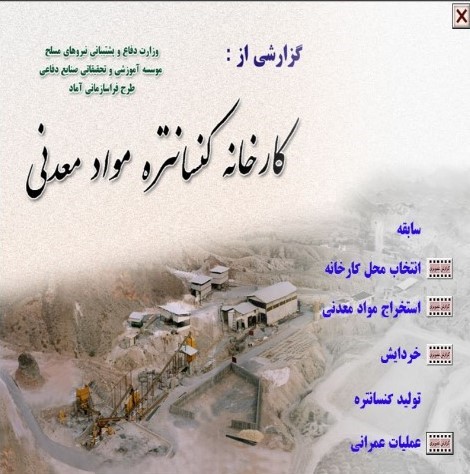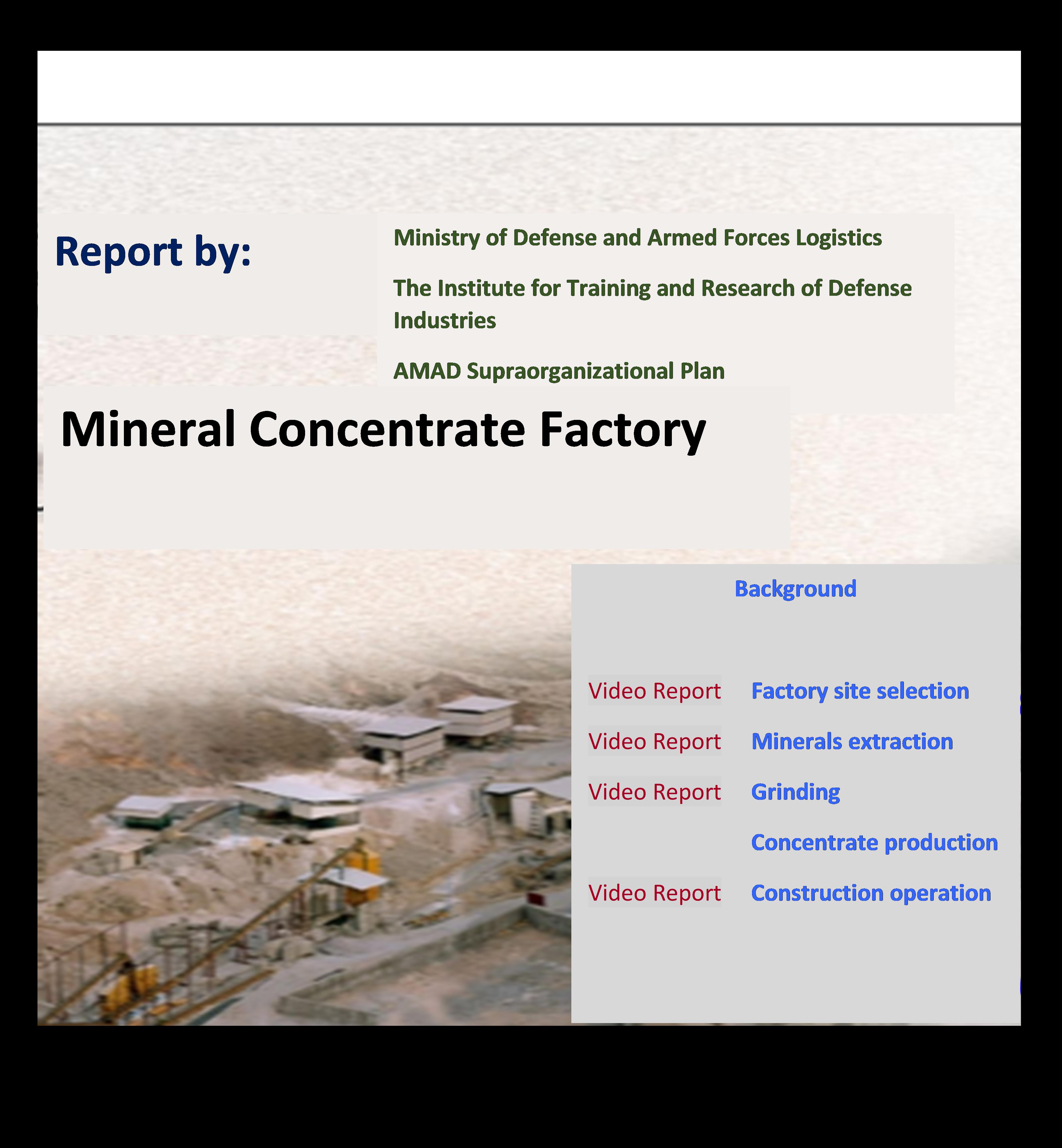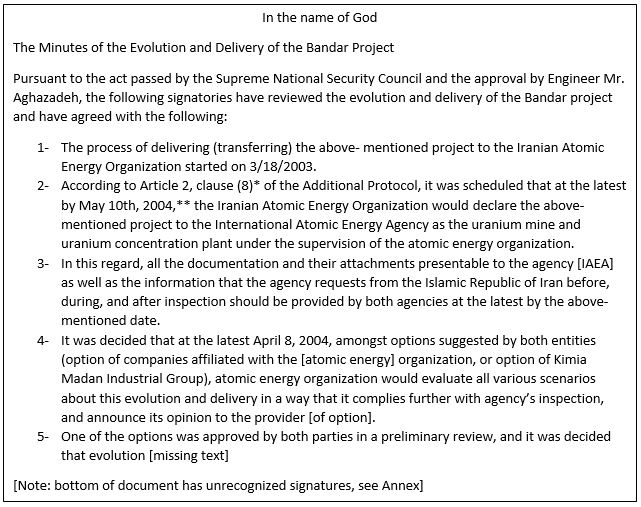Reports
Summary of Report: Anatomy of Iran’s Nuclear Deception and How Iran Benefited
by David Albright, Olli Heinonen, Frank Pabian, and Andrea Stricker
March 6, 2019
Iran’s Nuclear Archive contains considerable new information about its past nuclear weapons program including documentary evidence showing Iran’s deceptions in its declarations to the International Atomic Energy Agency (IAEA) about its past military nuclear activities. This summary discusses a report that illustrates one case of deception and the value of the new documentary information, when combined with other existing public documentation, by considering the Gchine uranium mine and yellowcake production plant, or “mill,” located in southern Iran near Bandar Abbas. 1 The product of Gchine, or alternatively called in the archive the Bandar Project, was uranium ore concentrate or yellowcake. The Gchine mine and mill was being built in the early 2000s as part of Iran’s nuclear weapons program, codenamed the Amad Plan. It would have produced the key nuclear source material for Iran’s production of highly enriched uranium (HEU) for nuclear weapons. Iran misled the IAEA by denying that Gchine was part of the Amad Plan and by falsely claiming that it was a long-standing civilian nuclear program under the Atomic Energy Organization of Iran (AEOI).
Documents not available to the IAEA prior to the seizure of the Nuclear Archive (alternatively called the Atomic Archive), show concretely that Gchine was originally part of Iran’s covert nuclear fuel cycle aimed at the production of nuclear weapons, directly contradicting Iran’s multiple declarations to the IAEA. The figure below is a PowerPoint presentation title page and its translation that discusses a Mineral Ore Concentrate Factory, with an image of Gchine. The presentation is clearly marked with “Amad Supraorganizational Plan,” by the Institute for Training and Research on Defense Industries of the Ministry of Defense and Armed Forces Logistics (MODAFL). The presentation contained videos showing factory site selection, minerals extraction, grinding and concentrate production, and construction operation. This demonstrates that the Gchine mine was originally owned by MODAFL, and was intended as part of the Amad Plan.


As part of its deception strategy, Iran told the IAEA in 2008 that “the exploitation of the uranium at the Gchine mine, as well as the ore processing activities at the Gchine uranium ore concentration plant (UOC), have always been and remain the responsibility of the AEOI.” Another document in the archive (see next page) demonstrates that this statement is false.
This document shows the process of Iran transferring ownership of the Gchine mine and mill from the military to the AEOI and making it appear longstanding to the IAEA. The document is a record of decisions reached by a senior Iranian leadership group. It discusses this transfer of ownership, called “evolution and delivery,” and a declaration to the IAEA of the Bandar Project (Gchine). The document states that the “process of delivering the above-mentioned project to the Iranian Atomic Energy Organization started on March 18, 2003.” This date is soon after the start of a round of controversial inspections of Iran’s previously undeclared uranium enrichment program that ultimately showed that Iran had violated its safeguards agreement. In an apparent order designed to create a more convincing cover story, the document states, “It was decided that at the latest April 8, 2004, amongst options suggested by both entities (option of companies affiliated with the [atomic energy] organization, or option of Kimia Madan Industrial Group), atomic energy organization would evaluate all various scenarios about this evolution and delivery in a way that it complies further with agency’s inspection, and announce its opinion to the provider [of option].” Based upon subsequent Iranian declarations, Kimia Maadan was selected to play this cover story role. Kimia Maadan, which was by implication not affiliated with the AEOI, was reportedly the contractor for the Amad project to build Gchine, making the cover story easier to construct.
This transfer provided a cover of civilian control over the facility in the face of encroaching international inspections and building demands from the international community on Iran to reveal the nature of its secret, military-run nuclear weapons program, a step Iran had no intention to comply with. Part of this effort was a secret Iranian attempt to keep significant military fuel cycle activities intact. In the case of Gchine, Iran’s only source of domestically produced uranium, it used overt means by declaring it as a civilian facility.
Despite Iran’s declaration, Gchine was never intended for or capable of meeting Iran’s nuclear power reactor requirements. Several years ago, the Institute assessed the output of the Gchine mine as being inadequate by an order of magnitude to meet the refueling requirements of a single 1,000 MW electric nuclear power reactor. However, the output of the Gchine mine is adequate for a nuclear weapons program based on highly enriched uranium. A weapons program needs far less yellowcake than a commercial nuclear power program.
The IAEA suspected Gchine’s original purpose and had obtained information from member states and other sources that indicated that the Gchine mine was a potential source of uranium for use in undeclared nuclear activities in the period 2000-2003. Iran’s reaction to this body of evidence was to consistently deny the IAEA’s allegations about the ownership and nature of Gchine. Iran provided extensive supporting, albeit deceptive, documentary information to back up its claims. There were a few senior IAEA officials and member states who sought to discount the evidence, but given that some of the key information was subject to challenge or interpretation, the IAEA did not take a tough position with Iran on the issue of Gchine. The IAEA’s February 2008 safeguards report stated: “The information and explanations provided by Iran were supported by the documentation, the content of which is consistent with the information already available to the Agency.” But the report did not bring the Gchine saga to closure, stating, “However, the Agency continues, in accordance with its procedures and practices, to seek corroboration of its findings and continues to verify this issue as part of verification of the completeness of Iran’s declarations.”
The IAEA has not issued a different assessment since 2008. The documents in the archive establish that Iran consistently misled the IAEA about Gchine and built it originally for use in a covert nuclear fuel cycle aimed at nuclear weapons production. As part of reorienting its nuclear weapons program in late 2003, Iran decided to deceive the IAEA as part of a strategy to maintain this facility as a vital part of its latent nuclear weapons capabilities. It is time for the IAEA to correct its 2008 assessment and for the international community to renew its efforts to ensure Iran does not build nuclear weapons.
A page from a translated record of decisions of a senior group of Iranians following an act of the Supreme National Security Council of Iran, then chaired by current Iranian president Hassan Rouhani, and its approval by the then-head of the AEOI, indicating plans to transfer a semblance of ownership of the Gchine mine and mill from the military to the AEOI, and to make it appear longstanding to the IAEA. The page is from a three-page document on this decision. Prior to this decision, Gchine was under the control of the AMAD program under the Ministry of Defense and Armed Forces Logistics. Engineer Gholam Reza Aghazadeh at the time was head of the AEOI. The original page in Farsi can be found in the original report.
Comments on Document
*The correct clause of the Additional Protocol is 2. a. (v).
**Delayed until May 21, 2004.
Additional summaries of our Iran Nuclear Archive analyses can be found here.
1.The full version of the report is available at: http://isis-online.org/isis-reports/detail/anatomy-of-irans-deception-and- how-iran-benefited-irans-nuclear-archive-con or https://www.fdd.org/analysis/2018/12/19/anatomy-of-irans- deception-and-how-iran-benefited/ ↩


 twitter
twitter